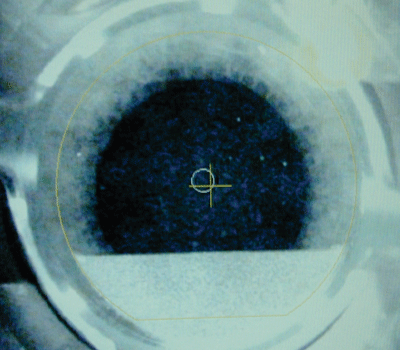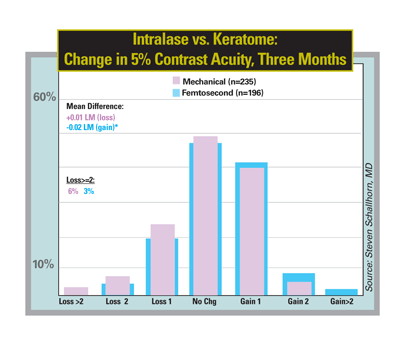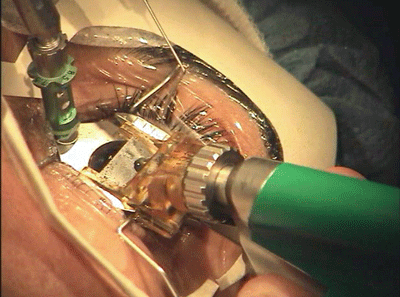Lasers and Blades
There's no question that LASIK with the IntraLase laser has captured the imagination of a number of refractive surgeons, and some surgeons use the device exclusively for their flaps.
According to Overland Park, Kan., surgeon Dan Durrie, if a refractive patient qualifies for a flap-based procedure (i.e., the cornea is thick enough and its topography isn't unusual), he prefers to make the flap with the IntraLase rather than a microkeratome.
"I definitely think IntraLase is better biomechanically and in terms of quality of vision and visual recovery," he says. "If I'm going to make a flap on the eye, I'd rather make one that I can control with the computer; I can control the size, the location, the thickness and the architecture of that flap. And I can do that better with a laser than I can with any of the microkeratomes. I haven't used a blade on the eye for several years."
In a 2003 study at his practice, Dr. Durrie compared IntraLase LASIK to microkeratome-assisted LASIK in 176 eyes of 88 patients, performing one of the procedures on the first eye and the other procedure on the fellow eye in each patient. The IntraLase eyes achieved better best-corrected and uncorrected vision by one month, and the results were more predictable. Ninety-six percent of the IntraLase eyes achieved 20/20 or better vision at three months, compared to 88 percent of the microkeratome patients.
The two devices' results eventually came closer to each other at a year, with slightly more keratome eyes seeing 20/20, but more IntraLase eyes seeing 20/16. The keratome eyes took longer to achieve contrast sensitivity scores comparable to the IntraLase group.
In the flap debate, the time required for the IntraLase to create a flap, usually around 36 seconds with the 30 KHz version, was one of the main aspects of the procedure attacked by IntraLase's opponents. This may change, however, as the new, 60- KHz upgrade becomes available.
"We now use the 60-KHz IntraLase," says Tijuana surgeon Arturo Chayet. "It takes about 18 seconds to do a flap. It's making a big impact. Because our staff is noticing the impact, they're much more enthusiastic in convincing patients of the benefits of going with IntraLase LASIK."
 |
| Some surgeons appreciate that the IntraLase allows them to specify a flap"s architecture, hinge size and location. John Wright, DO |
There have been a handful of other studies comparing LASIK performed with the IntraLase with procedures done with the microkeratome. One retrospective study compared the femtosecond laser in 106 eyes to the Carriazo-Barraquer (CB) microkeratome (Moria) in 126 eyes and the Hansatome (Bausch & Lomb) in 143 eyes.
At day one and three months, the uncorrected acuity results were similar among the groups. Best-corrected acuity was also similar at three months. Ninety-one percent of the IntraLase group were within ± 0.5 D of the intended refraction, compared to 73 percent of the CB and 74 percent of the Hansatome group (p<0.01). The IntraLase flaps were also significantly thinner (p<0.01) and varied less in thickness (p<0.01) than those created with the other instruments. The researchers reported that induced astigmatism in spherical corrections was significantly less with the IntraLase (p<0.01).1
Another group of researchers performed a small-scale, prospective, randomized trial analyzing the effects of creating a flap with the IntraLase and the Hansatome.2 In the study, the surgeons randomized nine patients (18 eyes) to flap creation with either of the two methods. The patients then underwent standard laser ablation.
The surgeons found that both methods produced statistically significant changes in defocus wavefront aberrations. There was a hyperopic shift in the Hansatome group after flap creation (p=0.04), but there were no statistically significant changes in the Hansatome group after the flap was made. The microkeratome also induced statistically significant changes in total higher-order aberrations that didn't occur with the femtosecond laser.2
San Diego refractive surgeon and Naval officer Steven Schallhorn has performed numerous independent studies examining various refractive procedures, partly because the military doesn't want its soldiers impeded by any vision-correction surgery they may decide to undergo. He and his co-workers have just completed a comprehensive analysis of IntraLase LASIK vs. microkeratome-assisted LASIK. The study involved 252 microkeratome patients and 200 IntraLase patients.
"I think the data is compelling that the femtosecond laser is the way to go to create a flap," he says. "We found that the femtosecond flap results in faster visual recovery, improved quality of vision as measured by contrast sensitivity and has a better safety profile."
As an example of the results, 70 percent of the IntraLase eyes saw 20/16 or better on day one, compared to 47 percent of the keratome eyes.
"So, while the mechanical keratome did very well on day one, the femtosecond did even better," says Dr. Schallhorn. "One of the advantages LASIK always had [over other procedures] was fast visual recovery, and here's a refinement of LASIK that has even faster visual recovery." He stresses that there was no difference in refractive outcome between the groups, so there wasn't a difference in nomograms.
"As far as the difference in contrast sensitivity, we find that the mechanical keratome did well, but the femtosecond simply did better," Dr. Schallhorn says. "If you look at it in terms of clinical relevance, which would involve asking what the chance was that someone will lose contrast sensitivity, it's low in both groups. The chance of losing contrast with the latest excimer laser ablation techniques is much lower than it was years ago with a conventional procedure—that's an important overlay on all this. We do see differences in the keratome, though. We find that the chance of someone losing contrast sensitivity is about twice as high if you've had a mechanical keratome vs. a femtosecond flap." Again, however, he stresses that the actual incidences were very low, with 6 percent of the mechanical group losing two or more lines of 5 percent photopic contrast acuity compared to 3 percent of the IntraLase group.
 |
"In a procedure where you had, perhaps, an incomplete flap that was made by a mechanical microkeratome beforehand, and you wanted to do a LASIK procedure on the eye, I think a keratome would be preferable because of the way the flap dissection can occur in the flap bed with the femtosecond laser," he says.
Many surgeons, however, aren't sold on the femtosecond. For many it's economics, with the IntraLase just being too expensive for them. Others feel whatever advantages the IntraLase might offer aren't overwhelming enough to switch technologies.
"I prefer to use the keratome," says Los Angeles surgeon Andrew Caster, who has access to both technologies. "For me, the flaps seem smoother with the keratome than the IntraLase. The seem to heal up a little faster and the patients get sharper vision faster with the keratome.
IntraLase has been touting the fact that its flaps are more predictable, but I think this is something that's not well understood. Though, statistically, the Hansatome seems to have a slightly higher standard deviation, it's actually a little more predictable than that would lead you to believe, because thinner corneas yield thinner flaps with the keratome in a fairly predictable manner. It's those thinner corneas in which we worry most about creating thicker flaps, and when you use the keratome on a thinner cornea you get a thinner flap… I was originally using the IntraLase for patients in whom I needed thinner flaps. However, my own measurements showed there was more variability in the flap thickness than I had been led to believe." He says that, on the one-day postop visits, microkeratome patients are seeing sharper than the IntraLase patients. This evens out after a week.
Dr. Caster was also put off by two cases of postop IntraLase complications.
"I've had two pretty serious cases of postoperative inflammation with the IntraLase," he says. "They did respond to steroids but they took a long time, and it was really a problem for the patients." He adds that there's speculation this complication will be reduced by the new 60-KHz laser, though.
"On the other hand, about every year or so, about once in a thousand cases, I get a partial flap with the keratome." says Dr. Caster. "But, on balance, I think the patients seem happier with the keratome procedure."
As an example of how the two procedures compare, Dr. Caster refers to a study from the fall of last year by Singapore's Hung Ming Lee, MD, that was presented at the American Academy of Ophthalmology meeting. He notes that the study was sponsored by Bausch & Lomb. In the study, the Hansatome flaps were closer to the attempted flap thickness of 120 µm, with an average thickness of 116 µm. The IntraLase flaps averaged 152 µm. The devices were equal in terms of standard deviation of flap thickness.
"I think there are minor differences between the two, as far as patient experience, efficacy and complication rates," Dr. Caster says. "So, a lot just has to do with doctor and patient perceptions, and their comfort levels. The IntraLase is also more expensive. And, when something is more expensive but more or less equivalent, that's a big negative."
Epi-LASIK
Competing for surgeons' attention is the quasi-flap based advanced surface ablation procedure epi-LASIK, which uses a device to separate the epithelium from Bowman's membrane in a manner similar to the LASIK flap cut. The epithelial sheet is then replaced after the ablation (though some surgeons now remove it). One of the most outspoken proponents of epi-LASIK is New Orleans surgeon Marguerite McDonald, who consults for Norwood Eyecare, a maker of epithelial separators. Dr. McDonald no longer uses LASIK in her practice.
"You can't have a flap-related complication if you don't have a flap," says Dr. McDonald. "You can't have buttonholes, micro- or macrostriae, diffuse lamellar keratitis, epithelial ingrowth, free flaps, slipped flaps or dislocated flaps. It's also safer for thinner corneas because there's less chance for ectasia.
"However, the real reason to consider surface ablation is that wavefront-guided results are even better than those of wavefront-guided LASIK, and surface ablation has a lower enhancement rate. This became apparent in 1999 when our group here in New Orleans had the honor of doing the first wavefront-based laser surgeries in the U.S. with the LadarVision platform. We found that, as outstanding as the LASIK results were, the surface ablation results were even better. But none of the laser companies was interested in going back to surface ablation at that time, because the issues of early postoperative pain and slower return of vision had not been adequately addressed."
Proponents of surface ablation think it's superior to LASIK because the LASIK flap induces aberrations. "At the 2001 meeting of the European Society of Cataract and Refractive Surgery, Ioannis Pallikaris, MD, and co-workers presented a paper that showed that when they separated the creation of the flap from the ablation by three months, they found a statistically significant increase in third- and fourth-order aberrations, before they ablated," says Dr. McDonald. "The increase was real but unpredictable for any individual patient, so that it could not have been programmed into the laser."
A prospective, randomized study of 17 patients found that there was a small but statistically significant increase in higher-order aberrations of around 30 percent two months after the flap cut. However, the researchers say that aberrations can be kept under control by waiting a couple of months before ablating the eyes. When they did this, the total and higher-order values of aberrations were nearly identical for both study and control eyes three months postop.3
As proof of surface ablation's effectiveness, Dr. McDonald recounts an analysis she did at her practice of a series of approximately 630 consecutive PRK cases that had at least three months of follow-up. She included any patient who fell within the U.S. Food and Drug Administration guidelines for surface ablation and who had a wavefront that could be captured. In the study, the enhancement rate was only 2 percent. She says this was impressive because her practice is mainly referral-based, and these were some of the patient characteristics:
• 16 percent had previous corneal surgery (LASIK, RK, etc.);
• 5 percent had more than one previous corneal surgery;
• 21 percent were over -6 D;
• 6 percent were over +3 D; and
• 5 percent were on cyclosporine A before surgery for tear-film problems.
Pain has been an issue with surface ablations, but Dr. McDonald thinks epi-LASIK is improving on that front.
"With new postop pain regimens we've developed, we've reduced the first day postop PRK pain scores from an average of 10 on a 1-to-10 scale down to a two," she says. "With epi-LASIK and modern pain control regimens, the pain scores should soon be even lower than two."
As an example of the progress against pain, Dr. McDonald lists an in-house study of 96 patients treated with epi-LASIK at the University of Crete. In it, Vikentia Katsanevaki, MD, PhD, reported average patient subjective pain scores of just below a one (on a 1-to-4 scale) at four hours postop. The mean pain scores decreased from then on.
LASIK patients still recover vision faster, however. "Ninety-five percent of epi-LASIK patients in my practice see 20/40 or better uncorrected on day one postop. That's not as good as LASIK, but these are still comfortable, functional people."
 |
| The epithelial separators used in the epi-LASIK procedure don"t cut a flap, they bluntly dissect epithelium away from Bowman"s membrane. Barrie Soloway, MD |
Barrie Soloway, MD, director of vision correction surgery for the New York Eye and Ear Infirmary, also likes epi-LASIK, though he still performs LASIK, too. He says he's seeing a slight advantage to epi-LASIK in terms of wavefront aberrations at six months onward, though it's not so huge "we can hang our hats on it." However, he notes that he performs 40 percent fewer retreatments with epi-LASIK than with LASIK. He thinks epi-LASIK may also give an extra layer of protection against the risk of ectasia, since it just uses an epithelial flap.
"If a patient is a candidate for both procedures, I tell him surface surgery is 'safer with a small s,' " he says. "I say that the current LASIK procedures are still relatively safe for him. There are downsides to LASIK in patients with low pachymetry or very dry eyes that make it compelling to move toward a surface procedure, however."
Some surgeons though, don't think there's a big difference between epi-LASIK and regular PRK.
"I haven't seen anything that shows improvements in the speed of visual recovery with epi-LASIK," says Dr. Schallhorn. "Epi-LASIK's been touted as the best of LASIK and the best of PRK, but I don't see that yet." He does, however, think surface ablation can yield excellent results.
With IntraLase impressing a number of surgeons, and surface ablation, either in the form of PRK or epi-LASIK, experiencing a resurgence, the two procedures appear to be on a collision course. Dr. Durrie is conducting a contralateral comparative study in which one eye of each patient undergoes IntraLase LASIK and the other gets surface ablation. Dr. Schallhorn is doing a similar study that doesn't involve contralateral treatment.
"By the time we were establishing the findings in our microkeratome-LASIK vs. surface ablation study, we decided to switch to the femtosecond laser, and did hundreds of primary patients with the IntraLase and compared them to hundreds of patients with surface ablation, because it was evident that the IntraLase resulted in a slightly better quality of vision and we wanted to compare the best to the best. We don't have any data on that analysis yet. Those are the results we're anxiously awaiting, because that study will compare the best LASIK procedure to the best surface procedure as we know it today."
1. Kezirian GM, Stonecipher KG. Comparison of the IntraLase femtosecond laser and mechanical keratomes for laser in situ keratomileusis. J Cataract Refract Surg 2004;30:4:804-11.
2. Tran DB, Sarayba MA, Bor Z, Garufis C, Duh YJ, Soltes CR, Juhasz T, Kurtz RM. Randomized prospective clinical study comparing induced aberrations with IntraLase and Hansatome flap creation in fellow eyes: potential impact on wavefront-guided laser in situ keratomileusis. J Cataract Refract Surg 2005;31:1:97-105.
3. Porter J, MacRae S, Yoon G, Roberts C, Cox IG, Williams DR. Separate effects of the microkeratome incision and laser ablation on the eye's wave aberration. Am J Ophthalmol 2003;136:2:327-37.



